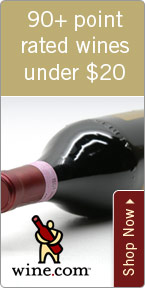The Unique Age-ability Of Wine

Wednesday - August 11, 2006
| Share
 Del.icio.us
Del.icio.usAfter recently partaking in several wine tastings with wines from the ‘60s and ‘70s, I came to thinking about wine age-ability. People ask me that all the time. “How do you think this wine will age?” or “when do you think this wine will be ready?”
So, what is happening in the bottle during aging? The polyphenols, which include tannin and pigment in a wine, start to bond and become longer chained, bigger molecules, thus precipitating out of solution and becoming a deposit at the bottom of the bottle. That’s why you regularly see a lot of sediment and encounter less tannin in older bottles of wine. The polyphenols and esters that make up all the aromatic and flavor components in a wine also undergo a change that results in an older wine smelling and tasting different than a young one. The alcohol and acidity in the wine do not change over time. If you taste the wine and it apparently has less alcohol or less acidity over time, it is actually everything else in the wine that changes around them.
Not all wines are meant to age - 99 percent of wine is made to be consumed as soon as you buy it off the shelf. That smallest percentage of wine is truly made for keeping. And keeping means under proper conditions: 55 degrees Fahrenheit with some humidity, away from light and vibration is ideal. (See my previous article on “Wine Abuse.”)
First of all, how do you like your wine? Do you like it young, exuberant, fruity, tannic and restless? Or do you like it mellow, complex, with secondary and tertiary flavors, developed, more earthy than fruity? A friend bought a case of 1987 Cabernet Sauvignon from Napa Valley at auction. He tasted one and thought it dreadful, and said I could have the other 11 bottles. I tried it, expecting the wines to be ravaged by oxidation or even maderized. The wine turned out to be delicious. It was just older than what my friend is used to drinking. I like the taste of older wine; it starts to smell like wine, not juice. Only you can say when you think it’s ready. Wine writers can only speculate as to how long a wine can age and when to drink it.
And you have to remember wine age-ability is not a linear sequence. The way wines age is not necessarily a bell-shaped curve. Each vintage has its own personality and its own evolution unlike any other vintage. Each individual wine must be taken on its own merits and qualities to decide when you should drink it. What I do look for in wines that I think will age well is concentration of flavor and aroma. If it doesn’t have it in the beginning, it will never have it.
But above all, I look for balance. If a wine has too much of or lacks in something like acidity, alcohol, tannin, sugar, the wine will only become more out of balance as it ages.
Whenever you drink your wine, young or old, it is just a snap shot in time of the wine’s life. You will never be able to share it, at that same moment, in that same stage or situation again. So enjoy it. Time stands still for nothing.
One for aging: 2004 ColinDeleger Chevalier Montrachet $250. Whoever is in charge of Heaven’s cellar is buying up this wine. It is truly heavenly!
One to drink now: 2000 Clendenen Family Vineyard Nebbiolo $35. I thought it was Barbaresco from a great producer that costs triple the price. Stellar wine.
Roberto Viernes is a master sommelier. E-mail .(JavaScript must be enabled to view this email address)E-mail this story | Print this page | Comments (0) | Archive | RSS Comments (0) |
Most Recent Comment(s):












